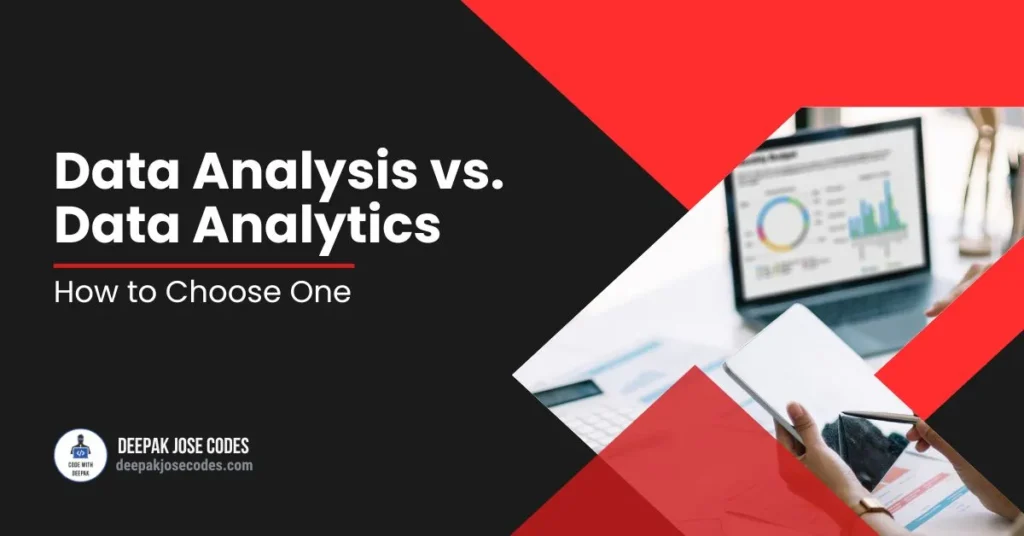In an era dominated by data, organizations of all sizes are leveraging its power to inform decisions, shape strategies, and drive innovation. As a result, jobs in data-related fields are increasingly in demand. Two terms typically appear among these roles: data analysis and data analytics. While these phrases may appear to be synonymous, they reflect diverse fields inside the data landscape. If you’re undecided about a career path, this article: Data Analysis vs. Data Analytics will walk you through the complexities of data analysis and data analytics, allowing you to make an informed decision based on your interests, abilities, and aspirations.
Let’s get started

Contents
Defining Data Analysis vs. Data Analytics
Before we get into the decision-making process, let’s define data analysis and data analytics: Simply put, you can think of data analytics as a superset of data analysis. In other words, data analytics includes data analysis as one of its components. Data analysis is a fundamental part of the broader process of data analytics.
Data Analysis
Assume you have a collection of jigsaw pieces and want to figure out what the picture looks like when you fit them together. Data analysis is similar to putting together puzzle pieces and looking for patterns in the colours and shapes. If you examine your grades in several areas over time, you may find that your maths scores generally improve in the second part of the school year. That is data analysis; you are reviewing the data you have to determine if there are any intriguing trends or patterns.
Data Analytics
Now let’s imagine you want to leverage your puzzle-solving abilities to forecast what the next puzzle you’ll get would look like. Data analytics is analogous to using what you’ve learned from putting puzzles together in the past to predict what future puzzles will be like. For example, if you see that you’re receiving more animal-themed puzzles throughout the summer, you can guess that the next problem you receive in July would be about animals as well. That is data analytics: you use your insights to make educated assumptions about what will happen in the future based on what you’ve observed in the past.
Now let’s see the factor to consider when choosing one of these as your career path.
Factors to Consider When Choosing:
1. Interest and Aptitude: Think about your natural inclinations and interests. Do you enjoy sifting through historical data to reveal patterns (data analysis) or are you intrigued by the potential of using data to forecast future trends (data analytics)? Examine your comfort level with numbers, statistics, and coding, as they are essential components of both areas.
2. Skill Set: Assess your current abilities and strengths. Data analysis necessitates knowledge of data cleansing, visualisation, and statistical analysis. And data analytics require Predictive modelling, machine learning, and potentially more sophisticated programming skills . Your current capabilities may have an impact on your decision.
3. Career Objectives: Where do you see your career going? Data analysis and analytics skills can be useful if you want to work as a business analyst, marketing analyst, or data scientist. Consider the positions that correspond to your long-term ambitions and work backward to find the best approach.
4. Tools and Technologies: Both professions make extensive use of a variety of tools and technologies. Excel, SQL, and visualisation tools such as Tableau are often used in data analysis. Google Analytics, Python, R, and machine learning frameworks are among the tools used in data analytics. Determine which tools speak to you and fit your learning style.
5. Industry Relevance: Certain sectors place a greater emphasis on data analysis or data analytics. Investigate the businesses that interest you and decide which data-related skill set is in high demand. For example, e-commerce may prefer analytics for predictive insights, but healthcare may require analysis to discover medical trends.
6. Educational Resources: Look into the availability of data analysis and data analytics courses, online tutorials, and certifications. Examine the curriculum, prerequisites, and learning outcomes to determine which field best fits your learning style and objectives.
7. Job Market Demand: Conduct market research to determine the demand for data analysts and data analytics specialists in the location and sector of your choice. A high demand may signify a plethora of job opportunities and possible professional advancement.
8. Adaptability and Evolution: Keep in mind that the data landscape is ever-changing. Analysis and analytics skills can compliment one other and make you more flexible to shifting industry needs. Many professionals move between these roles as their careers progress.
9. Experimentation and Exploration: Consider modest projects or internships to obtain hands-on experience in both subjects. This practical experience can provide useful insights into the duties and issues you may face on a daily basis.
Resources to Learn
Data Analysis Courses:
- Coursera – Data Science Specialization (offered by Johns Hopkins University) This series of courses covers data analysis using R, exploratory data analysis, data visualization, and more. Website: Coursera – Data Science Specialization
- edX – Data Analysis for Life Sciences (offered by Harvard University) This course focuses on using R for data analysis in life sciences, covering statistical techniques and visualization. Website: edX – Data Analysis for Life Sciences
- Udacity – Data Analysis Nanodegree This comprehensive program covers data analysis with Python, data wrangling, statistical analysis, and data visualization. Website: Udacity – Data Analysis Nanodegree
Data Analytics Courses:
- Coursera – Google Data Analytics Professional Certificate This series of courses covers data analysis using Google Analytics, SQL, data visualization, and business intelligence. Website: Coursera – Google Data Analytics Professional Certificate
- edX – Data Science MicroMasters (offered by UC San Diego) This program covers data analytics, machine learning, and big data technologies, providing a comprehensive data science foundation. Website: edX – Data Science MicroMasters
- LinkedIn Learning – Data Analytics for Business Professionals This course focuses on data analytics concepts for business decision-makers, covering data analysis techniques and tools. Website: LinkedIn Learning – Data Analytics for Business Professionals
Additional Resources:
- Kaggle Kaggle offers a variety of datasets and competitions to practice data analysis and data analytics skills. It’s a great platform to apply what you’ve learned in courses. Website: Kaggle
- DataCamp DataCamp provides interactive courses on data analysis and data science using Python and R. They offer a wide range of topics for beginners and more advanced learners. Website: DataCamp
Conclusion
Choosing between data analysis and data analytics necessitates a thorough examination of your interests, talents, professional ambitions, and the needs of your target industry. Finally, the decision should be based on your passion and strengths, but also taking into account the changing nature of the data world. Keep in mind that your career path can be a hybrid of the two, allowing you to prosper in a world where data dominates and insights drive growth. You can start as a data Analyst and move your way up to Data Analytics
For More Data Science Related Posts and Resources Check out: https://deepakjosecodes.com/category/data-science/
Comment down your thoughts and suggestions for future posts



Fantastic site A lot of helpful info here Im sending it to some buddies ans additionally sharing in delicious And naturally thanks on your sweat
Thank you for your kind words.🙏. Kindly share this with your friends
Ive read several just right stuff here Certainly price bookmarking for revisiting I wonder how a lot effort you place to create this kind of great informative website
Thank you for your kind words.🙏. Kindly share this with your friends